Events
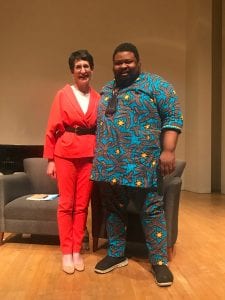
“You are what you eat.” I’m sure you’ve heard this expression, but have you ever thought about it literally? Michael Twitty and Marcie Cohen Ferris, two distinguished authors and chefs, participated in a compelling discussion in front of the Charleston community about this expression in terms of their knowledge and experience of Jewish, African American, and Southern foodways. Ferris described how her view of the Jewish south was influenced by her youth; as an American Jewish immigrant growing up and learning about her Russian Jewish grandmother through an old recipe box, Ferris reflected on her life using an “important lens” that was crafted by food. Similarly, Twitty emphasized and relayed the great history (of both African Americans and Jews) that he regularly discovers in the food that he cooks, eats, and teaches about. While teaching Hebrew to 7th grade students, he makes sure to include food in his discussions in order to instill the gravity of cooking on family stories and values. He says, “What you eat becomes a part of your narrative.” I loved this relationship becomes it reminded me of a quote by Shadi Martini (with whom we spoke just days before at an event about Syrian culture: See below!) regarding the recreation of one of his beloved meals (one that he can longer get in his own city), the Aleppo sandwich. He said that with every bite of food is “how you’re going to remember where you lived.”
From physically being displaced from your hometown, to losing a sense of community in a region, to simply forgetting your favorite childhood meals- there are many ways that cultural cuisine can be lost. But Ferris and Twitty have done a tremendous job in showing just how powerful food can be to sustain that special connection between the present and the past. They agree that the love, danger, intimacy, and violence that has come from the shaping of African American and Jewish foodways should not be forgotten, as they symbolize a historical story describing their identities, or their very own flags. Thanks to Ferris and Twitty, “we are what we eat” is no longer an expression, but a beautiful reality.
Written by Abbey Phillian
The Finale Part 1:

Working for Dr. Ravalico and her incredible program Global Foodways has been a true privilege and learning experience. The informative events that have been held here at the College of Charleston on the subject of slow food have been more enticing than I ever imagined, and the final event that rounded out the signature series was no exception. The finale was hosted on April 11th at College of Charleston’s Rita Liddy Hollings Science Center and featured a chocolate tasting provided by local sustainable chocolatier Bethany Nunn, as well as a lecture from Dr. Carla Martin. Dr. Carla Martin is both the founder and executive director of the Fine Cacao and Chocolate Institute and a lecturer at Harvard University in their African and African American Studies Department on the Global History of Chocolate. With her background and expertise on the aforementioned subject, it’s no wonder that Dr. Carla Martin drew the crowd in with her compelling information surrounding the delicious desert we enjoy indulging ourselves with. Her lecture “Chocolate Politics: How History, Multinational Corporations, Governments, NGO’s, and Critics Influence The Chocolate We Eat” detailed the importance of the overlooked delicacy and why the study and background should be of importance to those who enjoy it. While most people think of chocolate in terms of being a midnight snack or cheat-day reward, Martin acknowledges it as being a driving economic force and billion-dollar industry. She shared the statistic with the crowd that in 2017, twenty-two billion dollars worth of chocolate were sold. From a somewhat frightening perspective, this means that on average, twelve pounds of chocolate were consumed per person. The sheer expanse of chocolate consumption signifies the importance of chocolate that is being neglected by those who eat it. As Dr. Carla Martin contended in her lecture, “chocolate is huge,” and not only in terms of being a delicious type of sweet snack. Spanning beyond just consumer enjoyment, chocolate was actually used as a form of currency; it also was used in many ritual ceremonies and was the reason many women were provided with work. In fact, the women who were grinding the cocoa beans for the chocolate to be made used more calories by physical labor than they were generating with the sweet substance they were churning. In addition to explaining the less recognized importance of chocolate, Martin enlightened the audience with how their views of the delicacy may be skewed because of the types of sweets they’re spending their money on. While Dr. Martin generously provided the audience with Hershey Kisses to taste, it was not because she’s a strong advocate for the type of product Hershey creates and distributes. Her intention was quite the opposite actually, and the point she made was a very nice segway into the topics that Bethany Nunn would be discussing later on. In speaking on Hershey Kisses and other chocolate products along similar lines, Dr. Carla Martin asserted that the cocoa content in mass produced chocolate products is often very slim. For example, Hershey Kisses only have an 11% cocoa content. The Candyland that has sprouted because of manufacturers like Hershey in North America has devalued chocolate, and Dr. Carla Martin is one who aims to teach the true value and importance of chocolate in its most natural and genuine forms.
Written by Josie Cataldo
The Finale Part 2:
After the crowd was consumed by all of the information that Dr. Carla Martin filled their minds with, it was time for them to consume the delicious chocolate that local sustainable chocolatier Bethany Nunn provided them with. Sitting before me and all of my peers in the packed-full lecture hall were twelve samples of chocolate that we were to taste and test our knowledge with. However, the chocolate tasting process was not one to be rushed; before tasting each chocolate, Nunn would provide a preface with the flavors we would be experiencing and how each was natural and unique. In addition to providing the various college students, faculty, and Charleston residents with general information about the twelve chocolates before tasting, Nunn allowed the audience to savor the chocolates and then surprised them with the hidden flavors that they should be finding hints of. When tasting chocolate, it can be hard to enjoy it slowly and not scarf it down in one massive bite. However, with the carefully chosen chocolate samples that Nunn hand selected, the audience was able to experience a world of flavor that they never previously associated with the chocolate they were accustomed to eating. Before Nunn allowed the audience to delight in the unique and beautiful flavors of her chocolate, she gave the eager listeners an inside look at the life of one who works in a facility that manufactures and distributes hand-crafted chocolate bars. Her up-close perspective on the intriguing processes grabbed and held the attention of audience members like me who were not properly educated on the importance of certain aspects of chocolate. Once the audience was briefed on the process of making and distributing chocolate, it was time to taste. Now, I’m going to give you a little flavor profile for each of the twelve chocolates that were handed out to the crowd. Chocolate #1 was rainforest alliance certified and 70% dark chocolate; to me, it tasted like your average dark chocolate bar. Chocolate #2 was a bit more unusual and had flavors of chili, ginger, cinnamon-it was 100% cocoa ground down. Chocolate #3 was a chocolate that only royals could afford-this was a tid-bit of information I found to be interesting; how expensive can a quick desert such as chocolate really be? Chocolate #5 was a Criollo chocolate that was 73% cocoa ground down. Chocolates 6 and 7 were Forastero and Trinitario chocolates with 70% cocoa ground down. However, the flavors of the two chocolates varied significantly; chocolate 6 had earthy and pesto flavors whereas chocolate 7 tasted of tea. As the tasting progressed, the flavors became more unique and overpowering. Chocolate #8 was 100% cocoa liquor and chocolate #9 was cocoa tea. To round out the chocolate tasting was chocolate 12, one of the most exquisite pieces of chocolate I’ve ever tasted. The second I bit into the smooth, dark, delicious sample, my mouth was watering, overwhelmed by the striking scent and taste of lavender. The words that came out of Bethany Nunn’s mouth following the crowd’s tasting of chocolate #12 shocked everyone into silence. The beautiful lavender flavor that the audience was experiencing with chocolate #12 was merely a product of chocolate #1 sitting next to lavender for a few hours. Yep, you heard that right, chocolates 1 and 12 were in fact the same chocolate. This event that I had the privilege of attending was the perfect way to round out an incredible semester of working for Dr. Ravalico’s signature series Global Foodways, and I could not be more grateful for this humbling experience.
Written by Josie Cataldo


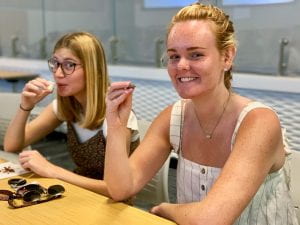
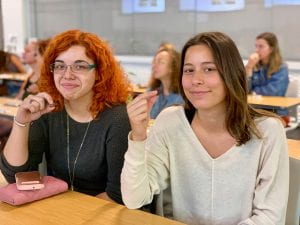







“Refugee Life/Refugee of Food: Syrian Culture in the Wake of Diaspora” at the Culinary Institute of Charleston Amphitheatre was one of the most incredible and inspirational Foodways events yet. The audience was engaged with cooking demonstrations, tastings, “very short story” readings, and most importantly, they were given a look into the lives of the amazing Mayada Anjari, Osama Alomar, and Shadi Martini.
To start off the night, Shadi Martini impressed the audience with all of the work he does as Director of Humanitarian Relief and Regional Relations for the Multifaith Alliance for Syrian Refugees. After informing the audience of the danger and risk he was exposed to in his passion for helping other people, Shadi professed that he thought of himself not as a refugee, but as an activist. This empowering statement aligns itself with Shadi’s selflessness and compassion, and it was an honor to hear about his mission.
Following the Q and A with Shadi Martini, Arabic-language poet Osama Alomar read the audience some of his poems and stories. Some of his poems were as short as five lines, but with so few words he was able to have an immense impact on the audience. His book of poetry features poems ranging from comedic to heart-wrenching, and his inviting personality shines through each piece. At one point in his Q and A, Osama said that when he writes about the dark, he also feels like he needs to write about the light, and this was apparent after he read some poems from his book “The Teeth Of The Comb and Other Stories.”
Last but not least was Mayada Anjari’s cooking demonstration. I think I speak for all when I say that Mayada and her story are an inspiration. How she has balanced the life she lives with being a chef and a mother at the same time is baffling. Watching her cook with such ease and fluidity was immensely impressive, it’s no wonder the crowds flocked to buy her cookbook “The Bread and Salt Between Us” after the event was over. Although I was not one of the lucky audience members to try one of her dishes, the ones provided by catering were absolutely delicious. I can only imagine what Mayada’s home made meals would taste like with all the passion and precision that she puts into them. I’m so incredibly honored to say I was able to attend an event that celebrated such inspirational people.
Written by Josie Cataldo














Over the past several decades, political activism in America has sparked a movement among men and women to support gender equality. As lucky as we are to have seen drastic improvement in our society, we have been blinded. We often forget that elsewhere in the world, gender inequality continues to exist to an extent that is simply unimaginable. It takes a special person like Vicki Wilde to show us what steps are being taken to improve gender disparity around the world, and how small life changes among women can truly foster positive community and state developments. Luckily, her busy schedule did not inhibit her from coming to The College to discuss her team’s great strides in women’s economic empowerment.
Wilde works in the agricultural development sector of the Bill and Melinda Gates Foundation, where she and 69 other specialists create ingenious ways to improve the financial inclusion, market inclusion, property, and/or platforms of women around the world. She highlighted the research that supports the benefits of self-help groups and emphasized how increasing a woman’s productivity and profitability can deconstruct negative societal norms. For example, Wilde has worked closely with the women of Bihar, India on ways to preserve the health of their goats, the only assets of poor women, to receive fair trading sales. (To learn more about some of this work, watch this short video about the Pashu Sakhis in Bihar that was posted by Bill Gates) Additionally, the agricultural development team has partnered with CARE to work with women in Malawi (Sub-Saharan Africa) to bring the profitable soy plant to the area.
Wilde made it very clear that in order to invoke change, you must “start where the people are.” She helped us do just that – she was like a teleporter; her photos, knowledge, and experience took us to places we’ve never been and showed us how collaboration, passion, and hope can drive impressive, positive change. Despite the differences we see between others’ lives and our own, there’s one thing that links us together more than anything else- we’re human, meaning, just as Wilde said, “all lives have equal value.” I think we can all look to Wilde as an inspiration to invoke positive change in our communities and use our knowledge and faith to slowly bring this dream of gender equity to reality.
Written by Abbey Phillian
On Thursday March 28th at College of Charleston’s Alumni Center, Harvard University professor Janet Beizer privileged College of Charleston students, professors, and residents with her talk “The Harlequin Plate: The Culture of Leftovers in 19th Century France.” Going into this event that was centered around leftovers, I wasn’t entirely sure of what to expect beyond an explanation of food that was made previously but never finished. I thought I already had a sufficient understanding of the word “leftovers” considering I had pizza from the night before waiting for me in my refrigerator, but I now realize how wrong I was. When the word “leftovers” came to mind before this talk, what popped into my head were visions of cold Chinese food and the mish-mash dinners that I prepare when I can’t make it to the store. However, when I stepped into the seminar room packed full of people, I knew this talk was about much more than the Domino’s pizza I wasn’t able to finish.

Beizer began her talk by introducing her intention: she would be highlighting the meaning and importance of the world “harlequin” as it applied to the “long 19th century,” otherwise known as the time span from the French Revolution to World War 1. As I soon learned from her innumerable knowledge on the subject, the word harlequin refers to a comedic figure of traditional pantomime. After being informed of this, I was wondering what on Earth the foolish character had to do with leftovers, but Beizer quickly answered my question. Harlequins used to adorn outfits that were trademarked for their colorful patchwork, and this smattering of colors and patterns found on their dress was reflective of the dishes that the poor people of France were consuming at the time. Harlequin plates were a compilation of the scraps of those who were fortunate enough to be consumers of fine French cuisine. Come to think of it, “scraps” may be a bit of an exaggeration; the harlequin sellers used to sell soup that was a product of the grease from plates that were cleaned by dish washers. This was a fact Beizer shared with the audience that made almost everyone in the room gasp with horror. While the picked-apart food of others may not seem the most appealing form of nutrition, this was the only option for many people living in France. After the leftovers of the higher-ups were discarded, sellers of harlequin plates, or what Beizer referred to as “bejewelers,” would salvage and essentially repurpose any food that they considered to be consumable. In applying the term bejewelers to the harlequins, Beizer followed up with the fact that leftover pigeons were often injected with water to make them more plumped up, and thus more appealing.
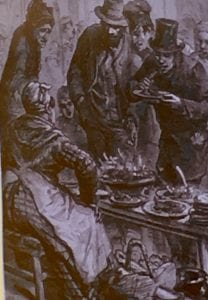
The harlequin plates offered those less fortunate a vehicle for daydreaming; they were able to imagine just for a moment what it would be like to live among the lavish. While those less fortunate in French society were intrigued by the idea that they were eating adaptations of meals traditionally consumed by the rich, the upper class was disgusted. The patch-work harlequin plates that were being bought and consumed by the poor were symbolic of the mixing of social classes, and this was something that higher society despised. Mixing in general was something vulgar in relation to French culture, specifically French cuisine. As Beizer informed the audience, there was and still is a sort of “choreography” to French cuisine, and this choreography prides itself on being tasteful and refined. Multiple courses being served at the same time was considered a scandal to the upper class because combination meant contagion. If food were to be mixed, social classes were too, and this was a great fear of those belonging to higher status.
Janet Beizer’s terrific lecture “The Harlequin Plate: The Culture of Leftovers in 19th Century France” took the audience on a journey that touched on the art, history, culture, and food of France, and I can honestly say it’s a journey I’ll never forget.
Following Janet Beizer’s lecture was a Zero Waste buffet and panel discussion with Dr. Bob Kahle from CofC’s Center for Livable Communities, Margaret Grant from Lowcountry Food Bank, and Mike Darrow from Feeding the Carolinas. The panelist discussion paired perfectly with Beizer’s talk; all three speakers discussed the importance of nutrition and food security and what they do for those who don’t know where their next meal is coming from. In listening to each of the speakers, I was informed that there are over 200,000 food insecure people in and around the Charleston area. This number was far greater than I expected and it came as a hurtful shock until Grant followed up with a food bank statistic. In the past year, the Lowcountry Food Back has compiled 31 million pounds of food to distribute to those who are food insecure. Yes, you read that right…31 MILLION pounds. This is enough food for 11.6 million meals, providing each food insecure person with 64 meals each. All three of the organizations that our panelists spoke on behalf of have been making great strides towards raising awareness for the food insecure while striving to decrease the amount of those struggling to obtain nutritious meals. We’re incredibly grateful for all of the work people like Dr. Bob Kahle, Margaret grant, and Mike Darrow are doing, and I can’t wait to see what accomplishments come next!
Written by Josie Cataldo
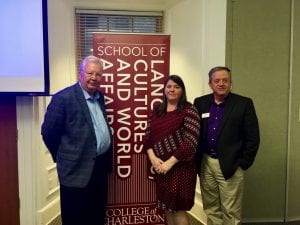


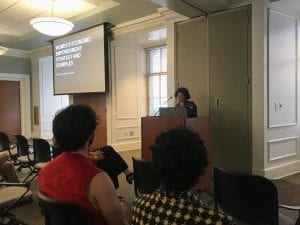




Students and staff from the Department of French, Francophone, and Italian studies joined Dr. Lisa Signori on February 25th, as she shared with us elements of French home cooking. In the kitchen of McAlister Residence Hall, Dr. Signori explained the step-by-step process (in French, of course!) of preparing two traditional French dishes- red cabbage & onion tart and fennel & zucchini soup. From preheating the oven, to chopping up vegetables, to keeping her station clean, she made cooking look effortless! Throughout the presentation, she gave us novices some tips and tricks alongside copies of each recipe. She assured, for example, that rounding out the dough for the tart did not have to fit a perfect shape, and that any dough left over could be “recycled” to be made into a little “tartlette.” What I found most interesting was that Dr. Signori was so comfortable with this art that she no longer needed a timer to mark the stages of the cooking process…she could smell when it was ready to move on! While the dishes were cooking, there was a group discussion about her family history as well as the French culinary traditions we have experienced in our own lives. The demonstration ended when we got to try the tart and the soup, which were accompanied by a variety of different cheeses. Thanks to Dr. Signori…bon appétit!
Written by Abbey Phillian
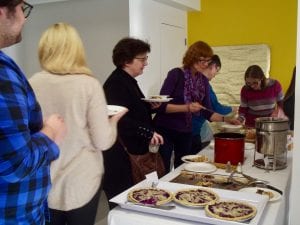






On Tuesday January 29th, several members of the Charleston community gathered to listen to Jonathan Bishop Highfield’s compelling lecture on foodways and displacement in the Western Cape of South Africa. Highfield is a professor at Rhode Island School of Design where he specializes in literary arts and studies and is the founder and director of the nature, culture, and sustainability graduate program. His talk was centered around the role of food as a major mark of communal identity and food memories, and he engaged the audience with stories of the now destroyed District Six in Cape Town. Throughout his lecture, Highfield told tales of despair and delight and indulged the audience with his mouth-watering descriptions of Cape Meley cuisine, a blend of food from India, Java, and the Philippines. By the end of the lecture, my mouth was watering from the onions, fish, and baked bread that we were told enveloped District Six. All the while, tears pricked my eyes as I remembered the unfortunate fate of the beautiful place. As Highfield’s lecture progressed and I learned more about the Khoi-Khoin culture and life and foodways in District Six, there was one thing in particular that stood out to me; the recipes of District Six were recounted in needlepoint. There are some pictures below of what these recipes would look like, and they’re absolutely breath taking. Not only do the ingredients of the delicious meals spark your taste buds, the beautiful colors and intricate detail makes you truly appreciate the culture of this once miraculous place. District Six has still not been built on top of, but it’s hard to replace a civilization that was so vibrant in its culture and traditions.
Written by Josie Cataldo




In the Jewish tradition, as Rabbi Davies explained, blessing the individual foods of a meal is a sort of “Thanksgiving.” The blessings ask God for permission to have “use of the bountiful world,” indirectly thanking him for the “blessed one,” or the source of food. The order of blessing is important, too. They begin by blessing the grains of the meal, followed by the fruit of the vine, the fruit of the tree, the fruit of the ground, and finishing with water, meats, and all other elements of the dish. Following Rabbi Davies, Imam Shamudeen expressed that the food itself is seen as blessing in the Islamic culture. When Muslims pray before and after the meal, they are simply expressing their gratitude of evoking a blessing from God. He was clear to distinguish that their expressions of gratitude are emphasized in their actions more so than in their words.There was a huge crowd for this occasion, more people in attendance than expected. The Charleston community came together and shared an experience that was personal, educational, and memorable. Open-minded and candid conversations about food, prayer, clothing, pilgrimage, and charity within the Islamic and Jewish faiths promoted nothing less than understanding and acceptance for all religious communities in the Holy City.
Written by Abbey Phillian





On Tuesday November 13th, members of Creekside Women’s Club of Mount Pleasant and Global Foodways gathered to serve homemade international cuisine to the families of critically ill children at MUSC. Delectable dishes such as Italian polenta, Korean scallion pancakes, and Chinese vegetarian dumplings were served, providing a diverse and colorful table of food to relieve the families from the minimal options on the hospital’s premises. The aroma of the eccentric, international dishes drifted into the hospital halls, drawing crowds of people into the close quarters. There was over an hour rush, families flooding in and discarding their just-bought bland meals for the free and more flavorful food generously provided to them. The expressions on the faces of the families walking into the room were priceless, awe-stricken. They were so unbelievably thankful for the little bit of home that was brought to them through the home-cooked meals provided by the Creekside Women and College of Charleston’s School of Languages, Cultures, and World Affairs. Community outreach is at the heart of Global Foodways, and through the event at MUSC held on Tuesday, the organization took yet another step towards their goal to inspire, enrich, and engage the people of South Carolina.
Written by Josie Cataldo












Interviews
Watch these videos to learn more about unique courses offered at CofC!
Food, Culture, and Sustainability in Italy 
More Pictures!








